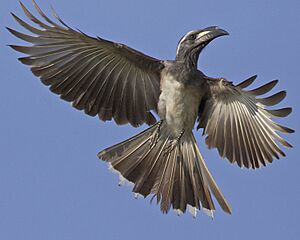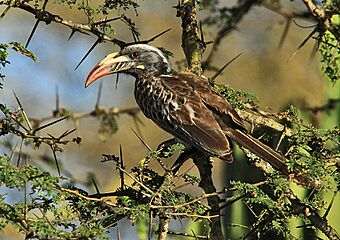African grey hornbill facts for kids
Quick facts for kids African grey hornbill |
|
|---|---|
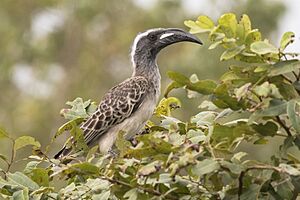 |
|
| Male L. n. nasutus in Senegal | |
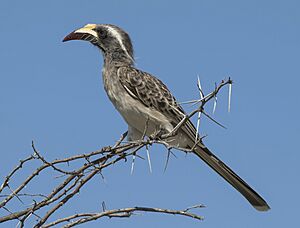 |
|
| Female L. n. epirhinus in Namibia Call of nominate subspecies, Kenya |
|
| Conservation status | |
| Scientific classification | |
| Genus: |
Lophoceros
|
| Species: |
nasutus
|
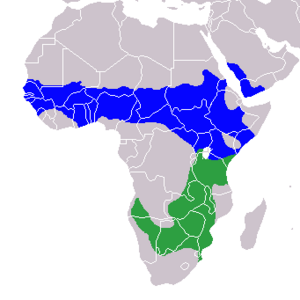 |
|
| L. n. nasutus
L. n. epirhinus |
|
| Synonyms | |
|
|
The African grey hornbill (Lophoceros nasutus) is a type of hornbill bird. These birds live in warm, tropical places around the world. You can find the African grey hornbill across most of sub-Saharan Africa and in the southwest part of the Arabian Peninsula.
Contents
About the African Grey Hornbill
What's in a Name?
The African grey hornbill got its scientific name, Buceros nasutus, from a Swedish scientist named Carl Linnaeus in 1766. Later, in 1833, two German scientists, Wilhelm Hemprich and Christian Gottfried Ehrenberg, created a new group of birds called Lophoceros. The African grey hornbill was moved into this group in 2013.
The name Lophoceros comes from ancient Greek words. Lophos means "crest," and kerōs means "horn." The second part of its name, nasutus, is Latin for "large-nosed." This makes sense because hornbills have big, curved bills!
There are two main types, or subspecies, of the African grey hornbill:
- L. n. nasutus: Found from Senegal and Gambia to Ethiopia, central Kenya, and southwest Arabia.
- L. n. epirhinus: Lives from southern Uganda and southern Kenya to northern South Africa.
How to Spot an African Grey Hornbill
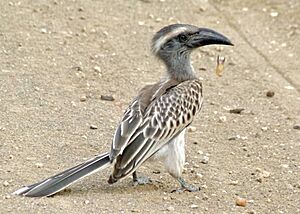
The African grey hornbill is a large bird, growing to about 45 to 51 centimeters (18 to 20 inches) long. It's one of the smaller hornbills, though! Its feathers are mostly grey and brown. Its head, flight feathers, and long tail are darker.
You might see a white line on each side of its head. Another white line goes down its back, but you can only see this when the bird is flying.
Their long, curved bills have a small bump called a casque on top. This casque is bigger on male birds than on females. Males have a dark upper bill with a creamy-yellow mark. Females have a bill with three colors and a red tip. Young birds have bills that are all blackish at first.
These birds fly in a wavy, up-and-down way. You can often hear them making a loud, piping sound that goes pee-o pee-o pee-o.
Where They Live
African grey hornbills live in many parts of sub-Saharan Africa. They like open woodlands and grassy areas called savannahs.
Daily Life and Habits
Nesting and Raising Chicks
When it's time to lay eggs, the female African grey hornbill finds a tree hollow. She lays two to four white eggs inside. Then, she seals off the entrance with a special "cement" made of mud, droppings, and fruit pulp. She leaves only a small opening, just big enough for the male to pass food through.
While the female is inside incubating the eggs, the male brings food to her and the chicks. When the chicks and the mother get too big for the nest, the mother breaks out. She then helps rebuild the wall. After that, both parents work together to feed their growing chicks.
What They Eat
African grey hornbills eat many different things. They are omnivorous, which means they eat both plants and animals. Their diet includes insects, fruits, and small reptiles. They usually find their food while perched in trees.
Gallery




